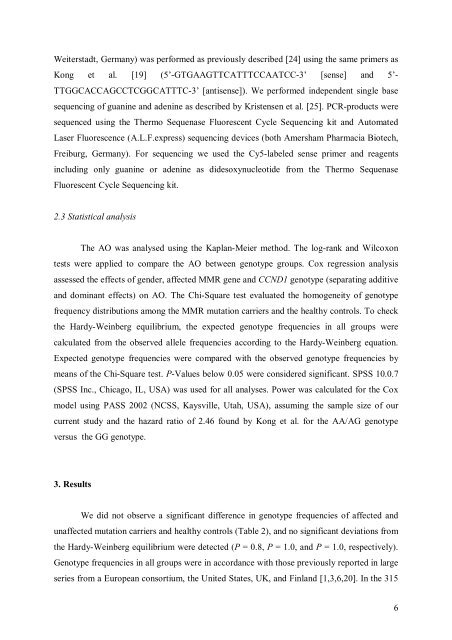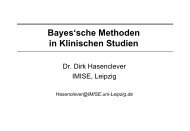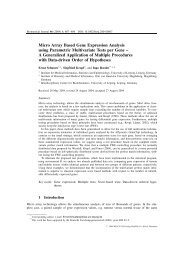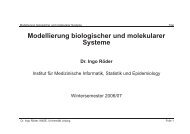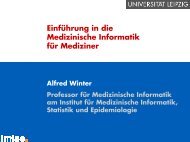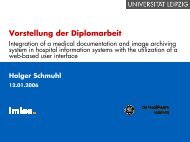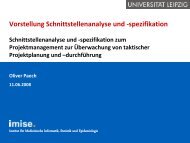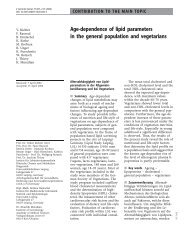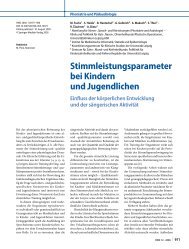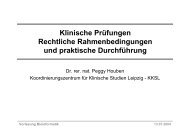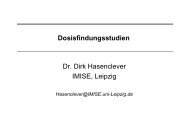MS-1513 CCND1 and HNPCC by Kruger et al. revised - IMISE
MS-1513 CCND1 and HNPCC by Kruger et al. revised - IMISE
MS-1513 CCND1 and HNPCC by Kruger et al. revised - IMISE
You also want an ePaper? Increase the reach of your titles
YUMPU automatically turns print PDFs into web optimized ePapers that Google loves.
Weiterstadt, Germany) was performed as previously described [24] using the same primers as<br />
Kong <strong>et</strong> <strong>al</strong>. [19] (5’-GTGAAGTTCATTTCCAATCC-3’ [sense] <strong>and</strong> 5’-<br />
TTGGCACCAGCCTCGGCATTTC-3’ [antisense]). We performed independent single base<br />
sequencing of guanine <strong>and</strong> adenine as described <strong>by</strong> Kristensen <strong>et</strong> <strong>al</strong>. [25]. PCR-products were<br />
sequenced using the Thermo Sequenase Fluorescent Cycle Sequencing kit <strong>and</strong> Automated<br />
Laser Fluorescence (A.L.F.express) sequencing devices (both Amersham Pharmacia Biotech,<br />
Freiburg, Germany). For sequencing we used the Cy5-labeled sense primer <strong>and</strong> reagents<br />
including only guanine or adenine as didesoxynucleotide from the Thermo Sequenase<br />
Fluorescent Cycle Sequencing kit.<br />
2.3 Statistic<strong>al</strong> an<strong>al</strong>ysis<br />
The AO was an<strong>al</strong>ysed using the Kaplan-Meier m<strong>et</strong>hod. The log-rank <strong>and</strong> Wilcoxon<br />
tests were applied to compare the AO b<strong>et</strong>ween genotype groups. Cox regression an<strong>al</strong>ysis<br />
assessed the effects of gender, affected MMR gene <strong>and</strong> <strong>CCND1</strong> genotype (separating additive<br />
<strong>and</strong> dominant effects) on AO. The Chi-Square test ev<strong>al</strong>uated the homogeneity of genotype<br />
frequency distributions among the MMR mutation carriers <strong>and</strong> the he<strong>al</strong>thy controls. To check<br />
the Hardy-Weinberg equilibrium, the expected genotype frequencies in <strong>al</strong>l groups were<br />
c<strong>al</strong>culated from the observed <strong>al</strong>lele frequencies according to the Hardy-Weinberg equation.<br />
Expected genotype frequencies were compared with the observed genotype frequencies <strong>by</strong><br />
means of the Chi-Square test. P-V<strong>al</strong>ues below 0.05 were considered significant. SPSS 10.0.7<br />
(SPSS Inc., Chicago, IL, USA) was used for <strong>al</strong>l an<strong>al</strong>yses. Power was c<strong>al</strong>culated for the Cox<br />
model using PASS 2002 (NCSS, Kaysville, Utah, USA), assuming the sample size of our<br />
current study <strong>and</strong> the hazard ratio of 2.46 found <strong>by</strong> Kong <strong>et</strong> <strong>al</strong>. for the AA/AG genotype<br />
versus the GG genotype.<br />
3. Results<br />
We did not observe a significant difference in genotype frequencies of affected <strong>and</strong><br />
unaffected mutation carriers <strong>and</strong> he<strong>al</strong>thy controls (Table 2), <strong>and</strong> no significant deviations from<br />
the Hardy-Weinberg equilibrium were d<strong>et</strong>ected (P = 0.8, P = 1.0, <strong>and</strong> P = 1.0, respectively).<br />
Genotype frequencies in <strong>al</strong>l groups were in accordance with those previously reported in large<br />
series from a European consortium, the United States, UK, <strong>and</strong> Finl<strong>and</strong> [1,3,6,20]. In the 315<br />
6


